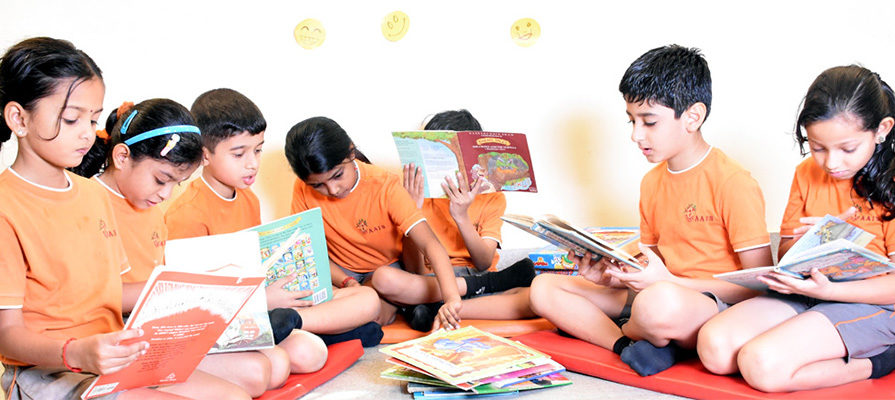Welcome to a blog on education, on schools, on learning, and sometimes on AAIS. While so much is done at AAIS, not enough is shared with the community, so we thought to set up a platform that allows members of the school community to discuss and better understand various aspects of school education
Today it appears several schools have the word ‘international’ attached to their names. Yes, we’re one such school. Akshar Arbol International School or AAIS. Does the word ‘international’ signify anything? At AAIS we believe it does.
One obvious fact is that we offer international programmes. Today we’re going to consider the nature of the programmes offered to our students from Grade ELC 2 to Grade 12.
Demystifying the PYP Curriculum Model

The IB Primary Years Programme (PYP) is represented as a set of concentric circles in yellow. One often wonders what this visual means. The core of the Programme philosophy is expressed viz this circle, known as the PYP Curriculum Model; or more informally as the PYP Circle.
At the core of the Circle is the IB Learner Profile. The heart of the Programme lies in the development of learners who exhibit the ten learner profile attributes. We recognize that these attributes do not develop in one-shot, rather, their development is supported by what lies in the circles around the learner profile.
The Concepts, Attitudes and the Approaches to Teaching and Learning support the development of the Learner Profile. Learning in the PYP is at a conceptual level, across the various disciplines. The attitudes play a significant role in the development of the learner profile – they are the seedlings that promote the growth of the attributes. Learners are required to reflect on the attitudes that they are developing over a period of time. The Approaches to Teaching and Learning define the Written (What is to be learned?), the Taught (How is this to be taught?) and the Assessed (How will the assessments happen?) Curriculum.
The Exhibition is a culmination of the learning in the PYP Years. It is a celebration of the learning – a graduation of sorts into middle school. Central to the PYP Exhibition is the need to take Action, arising out of student learning.
The six subjects of the PYP are then listed, followed by the six trans-disciplinary themes. Together, these define the body of knowledge in the PYP. Knowledge is not seen as a mere assimilation of factual information across the six subject areas. Instead, knowledge is seen as being significant and engaging content and concepts, which are not always taught as single subjects. They are dealt with in a manner that transcends these subjects, leading to trans-disciplinary planning and inquiry.
Finally, the outermost circle talks of International-Mindedness encompassing the whole programme!
The progressive learning path…

Today’s parents and students have a wide range of curriculum options that they can choose from. The Cambridge International Examinations [CIE] is one such globally recognized curriculum that prepares learners for life by enabling them to develop a curiosity and passion for learning. In the middle years the Cambridge Secondary 1 offers a flexible programme for developing skills in learners aged 11 to 14 years. The programme is designed with the aim of introducing concepts in the three core subject areas: English, Mathematics and Science. These subjects have clear objectives set to provide an opportunity for active learning and enhance creativity in the students. The Cambridge Secondary 1 has external assessment at the end of grade 8 in the three core subject areas. The humanities and languages have flexible curriculum to be planned by the school keeping in mind the context in which the school operates.
Cambridge Secondary 1 progresses into the IGCSE, the qualification earned on completing Grades 9 and 10. For this two-year programme a wide range of subjects is offered. Students are encouraged to choose subjects from the five groups: Language, Mathematics, Sciences, Humanities and Vocational streams. The IGCSE provides the base for advanced study. In addition to wide subject choices, the subjects have varying levels of difficulty that students can choose. This makes the curriculum suitable for all students as they can customize their learning according to their interest and capabilities. IGCSE assessments that take place at the end of two years include written and oral assignments, coursework and practical assessments, helping to extend opportunities for students to demonstrate their understanding and application of the subject content in multiple ways. IGCSE examinations are offered in one of three sessions during the year: May-June, October- November and the exclusive session for India in February-March.
Deep subject understanding and the development of independent thinking skills are the focus of the AS/A level qualifications offered by the Cambridge. The AS/A level courses are challenging ones that prepare students for access to higher education at world-renowned universities by equipping them with knowledge, understanding and skills in thinking logically, presenting coherent arguments, reasoning, evaluating and decision making.
The DP circle:

IB programmes are represented in concentric circles, the yellow being the PYP as mentioned above, while the Diploma Programme or DP is represented in blue. As with the PYP, the DP too places the learner at the centre, supported by the layers of the programme. The development of the learner is reinforced through the approaches to teaching and learning, in short the ATLs, mentioned in the second concentric circle. These approaches emphasise how learning is nurtured and include thinking, communication, social, self-management and research skills and form part of the teaching-learning process.
Moving outwards, the third concentric circle represents the Core of the DP: Theory of Knowledge, Extended Essay and Creativity, Activity, Service (CAS). These are independent elements that provide an opportunity for students/learners to implement and exhibit conceptual understanding and skills even as they explore the connections among the subjects represented in the fourth circle. The core is special to the DP as it balances academic depth with application and holistic learning.
The fourth concentric circle refers to the six broad academic groups including Studies in Language and Literature, Language Acquisition, Individuals and Societies, the Sciences, Mathematics and the Arts. With several subjects offered under each group, a student chooses one subject from each of the first five groups, and a subject under Group 6 or one more from one of the other groups (1 – 5).
As a circle represents wholeness, the DP aims to deliver a total programme that not only delivers extensive knowledge of the subjects, but also an educational experience that challenges students to apply their knowledge and skills in a variety of ways. Interaction of the four circles and the learner at the centre allows this learner to gain the international-mindedness that is represented in the outermost circle of the programme.

As shown above, all students at AAIS participate in these international programmes from the time they join our school to the time they graduate.
And yet is this the only reason we call ourselves an ‘international’ school?
Look out for the next issue of this blog that focuses on the nature of international education.
Source:
Pic Credits:
http://connection.sagepub.com/
http://dubaisurvivalguide.com/
About the Authors:
This piece was put together by members of the AAIS School Committee, Akila Srinivas, Latha Muthukrishnan, Prabha Dixit, Priya Dixit and Padmini Sankaran with a view to clarifying the idea of international education among the AAIS school community.



